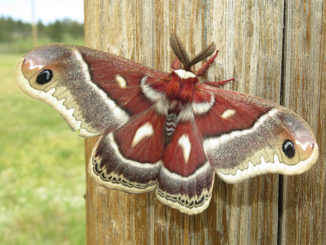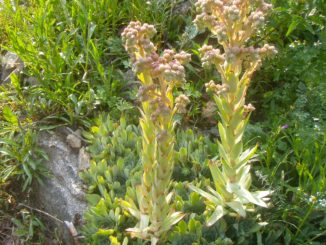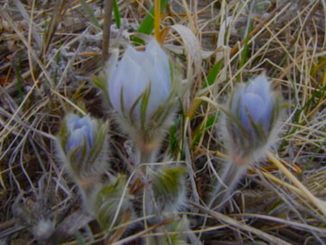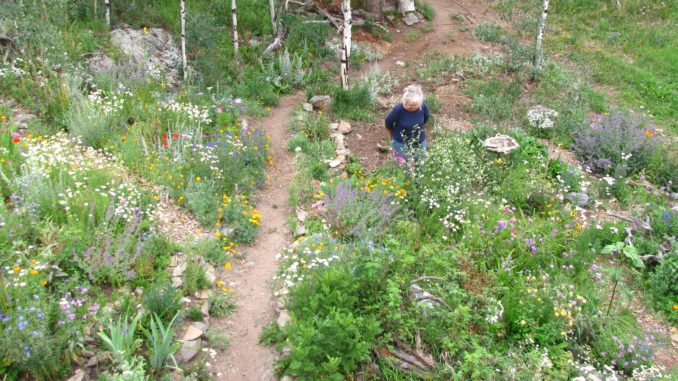
Sally Roth
[email protected]
“Oh, this is the kind of garden I want! So beautiful, and it just takes care of itself!”
We’ve had a number of first-time visitors at our place this summer, and every single one has said some variation of that, as soon as they step out of their car.
I smile and thank them, then quickly shift the conversation to something else.
Because… little do they know.
Rough estimate of the time I spend on achieving that naturalistic “wildflower” look these visitors love?
Easily two hours a day. Four to six hours, if I’m not occupied doing what I call “work-work,” meaning sitting inside at the computer.
The other thing I’ve heard over and over this summer: “I tried planting wildflowers, but they sure didn’t look like this! I guess I just don’t have a green thumb.”
That green thumb thing? That’s a myth.
Our thumbs are all the same color. What makes a thumb green is being obsessed enough with gardening (or houseplants, or hanging baskets, or porch pots) to want to invest the time a garden needs to look good.
A Dependable Foundation
I still see seed sellers trying to fool customers with the myth: “Just buy these wildflower seeds and toss them around!”
Um, no.
Clear a bed for those seeds, scatter them around, and maybe the first year it’ll look picture-perfect. Until the grass roots still in the soil and the bazillion lurking weed seeds take over.
Gardens take work. Work in the planning. Work in the deciding of what to plant, and which plant to put next to which. Work in removing grass to prepare the spot. Work in the weeding, mulching, watering, transplanting, on and on.
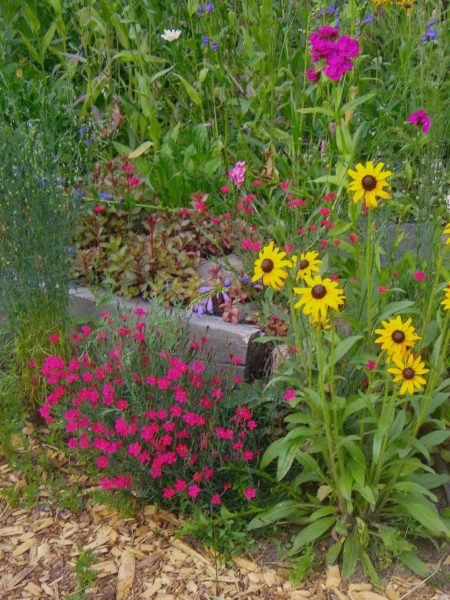
Neon-bright Dianthus deltoides ‘Brilliant’ covers ground fast—and self-sows!
But that work is a pleasure to plant lovers. Like an artist working on a painting, those of us who love gardening lose track of time when playing with plants.
“Going out to walk around,” I announce daily, shoving my pruners into my back pocket and grabbing my digger. Husband Matt knows I could be gone an hour. Or three.
Most folks, though, want “low maintenance.” Sorry, but that’s another myth.
Lower maintenance, sure. But sporadic maintenance, or none at all? It’s not going to look like a garden. It’s going to look like a weed patch.
Yes, I love to fiddle with my plants. But still, I’ve planted to reduce maintenance, because my knees and back can only take so much.
The biggest thing that visitors don’t notice about my “wildflower” garden? It’s anchored by perennials.
Perennials give me a foundation that I know will look good—and by “look good,” I mean “provide colorful flowers for months, throughout the growing season.” Then I fill in with fast-growing, fast-blooming annuals, the “wildflowers” that add to the airy, casual effect.
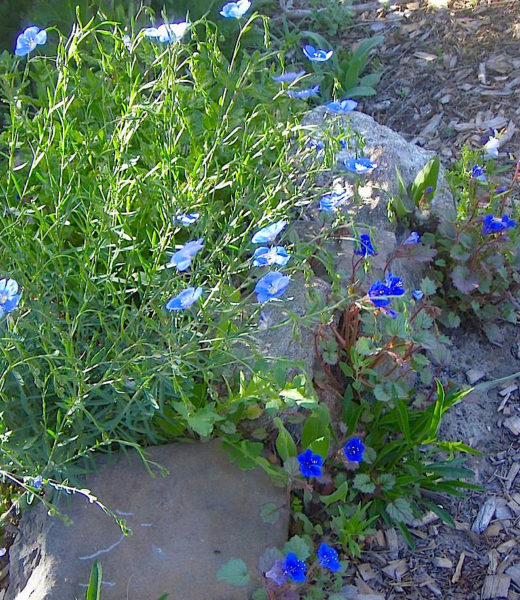
Cobalt-blue Phacelia campanularia, an annual wildflower from the Mojave desert, adds a deeper note below sky-blue perennial blue flax.
Meanwhile, I patrol daily with my pruners and digger, uprooting stray grass, clipping off seedheads to keep new flower buds coming, and transplanting seedlings every time there’s a rain, to make sure there’s plenty of color in every inch.
“Going out to play in the garden.” Yep, I could be out there for 20 minutes—or for hours.
Take Pleasure in the Process
“Majores fertilissium in agro oculum domini esse dixerunt,” wrote Pliny the Elder (23-79 AD). “Our fathers used to say that the master’s eye was the best fertilizer.”
He was only putting down in words what every gardener already knew: The shadow of the gardener is the key to a “green thumb.”
If you don’t have the time or inclination to spend hours in your garden every day, lower maintenance is possible.
You want a master class in how to do it?
Forget the manicured beds of colorful annuals at the Colorado State University trial gardens (1401 Remington Street, Fort Collins).
Instead, take a look at the plantings in the median of North College Avenue or of South Lemay Avenue in Fort Collins. Those wide beds are a mix of small trees, shrubs, grasses and trouble-free perennials, and they’re so beautiful—even in winter—that I almost forget being irritated by the traffic I’m stuck in. (Almost.)
You want the lowest maintenance yard? Keep your lawn, which needs only a weekly haircut.
You want a beautiful garden? Make sure it sees your shadow.
Support Northern Colorado Journalism
Show your support for North Forty News by helping us produce more content. It's a kind and simple gesture that will help us continue to bring more content to you.
BONUS - Donors get a link in their receipt to sign up for our once-per-week instant text messaging alert. Get your e-copy of North Forty News the moment it is released!
Click to Donate

